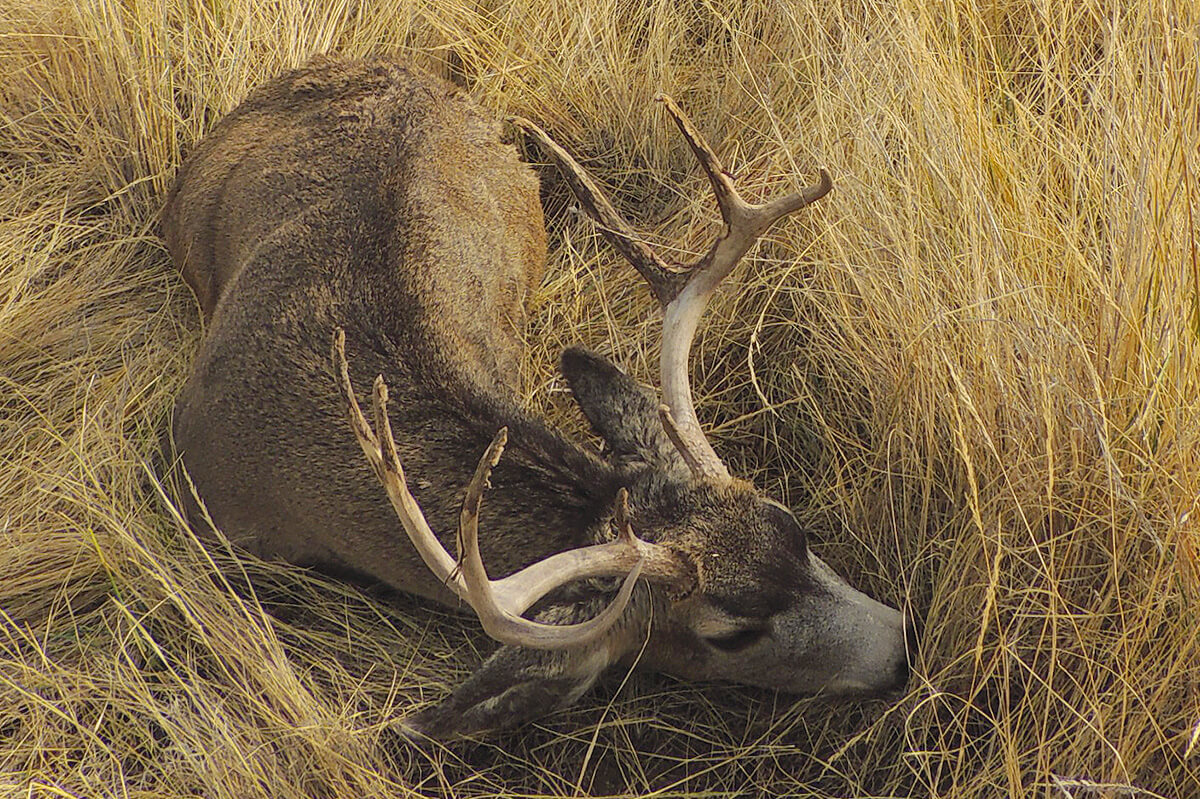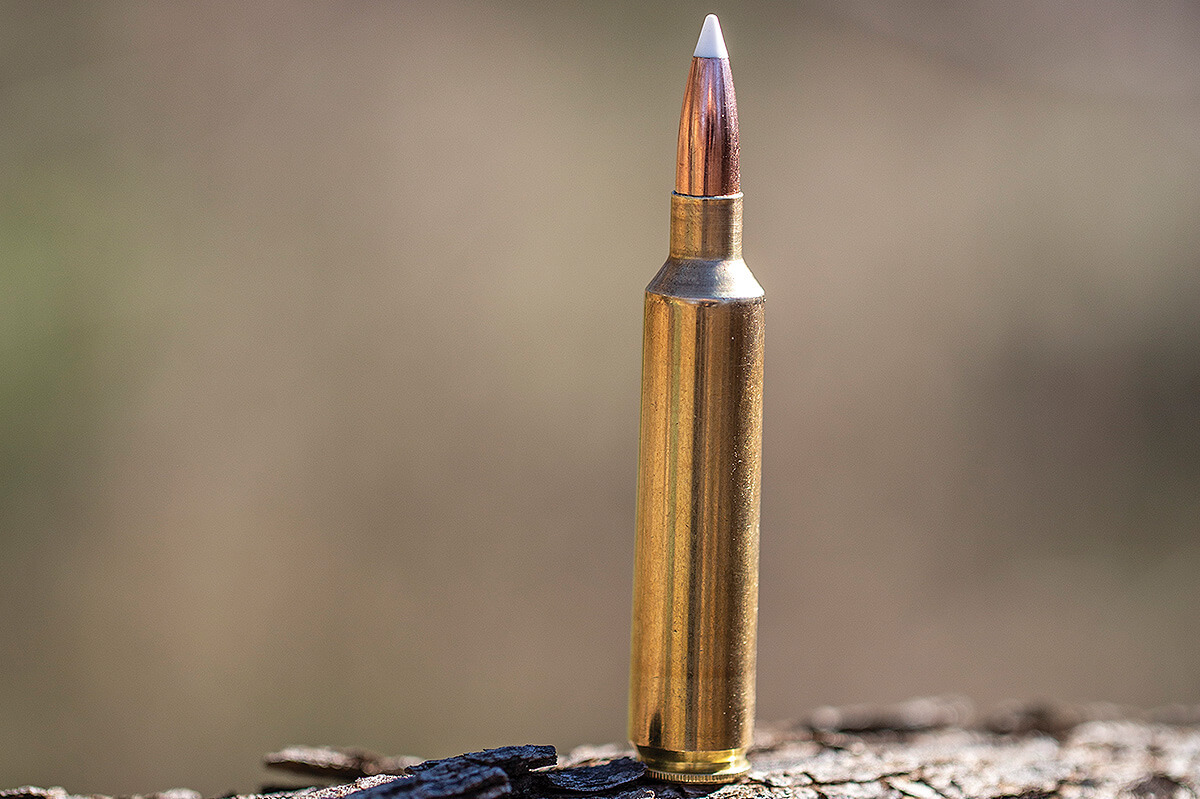
What to Look For
With a dry hunting season ahead, you’ll need to look for certain types of deer habitat and have the discipline to ignore other spots that in normal years would offer good hunting.
By October, mule deer are likely to be focused around the remaining water holes. Some deer will adapt and go to water in the night, sometimes traveling a mile or more from their core areas. It may be more important than ever to locate the little springs and seeps that other hunters don’t know about. That kind of detail cannot be found on a BLM map or a county road map. You, like the deer themselves, will have to search for those water sources.
Think about the types of habitat that consistently hold one good buck and the pockets that one good buck would seek out when hunting pressure ratchets up with the opening of rifle season. When prospecting for loner bucks in dry conditions, keep the following habitat types in mind.
An Acre of Browse
One side the forest ridge sloped down to sage; the other side was a grassy tilt with a few junipers and a grove of mountain mahogany. There was bitterbrush, shade and water within a quarter mile. A buck could eke out an existence here. All it takes is enough cover to hide one deer, I told myself. One good deer.
The pine trees cast long shadows in the bowl on the north side of the ridge. After a half-mile hike from the road, I slowed and slipped from tree to tree. Then, at the top, I glassed each new fold in the ground that opened up as I moved along.
The buck was a gray shape against the silver-green mountain mahoganies, but the shine of his antlers betrayed him. Forks well above the tops of the ears. Two-hundred-fifty-two yards.
There was a 150-grain Nosler Partition in the chamber. I eased the safety through to “fire” and found the buck and the crosshair, letting them drift into perfect alignment before pressing the trigger.
I had passed up a buck in a similar circumstance on opening morning. That buck had been a crab-clawed 4-by-4, and I was more than happy to have a second chance at a bigger buck.
What made this spot work was the acre of bitterbrush and mountain mahogany on the north face of the small ridge and water nearby where the buck could go after dark.
There were bigger patches of browse, but this was a solitary buck who calculated that it was safer to be here than to be hanging out with other deer. It does not take much cover to hide one deer. And if the deer is comfortable in the spot, it is more likely to show itself and make a mistake.
A Tiny Patch of Shade
A big buck can and will fold itself into a patch of shade no bigger than the front seat of an F-250.
This characteristic of big bucks—that they are willing to find niche cover to be safe and solitary—is a factor worth focusing on as you scout for and conduct your hunt, especially in habitat suffering from a lack of water.
The season I tagged my biggest mule deer was hot and dry and the hunting was hard. The third day of the season was the warmest yet. My hunting partner and I hiked onto the mountain where I had taken a good buck the season before, but water was scarce and fresh deer tracks were even scarcer. There were more tracks down lower, close to water and ranchlands.
There can come a point in a hunt when the intensity lets off, and we hit that point at about 1:30 in the afternoon. But even as we let our guard down and began to joke and whisper, we continued to keep watch.
A deer bounded out of its bed, just 40 yards away downwind. I saw gray flashing through the junipers and pulled up my binocular. A doe. Then a second and a third, making their escape. My hunting partner had his rifle up, ready. No antlers.
Still we watched, waiting. Too often we had been surprised by the sudden appearance of a doe or young buck then missed the opportunity at a larger buck when our guard was down.
This time the buck headed in the opposite direction the does had taken. My buddy swung his rifle to his shoulder as the deer bounded straight away. He fired and missed, the deer vanishing into the junipers leaving me with no shot.
As we had done for the past three days, we went into two-man drive mode, walking forty yards apart, parallel to each other through the junipers along the rim.
The sun beat down and there was little shade. We followed the buck as he made his way up and down through washes and around rocky outcroppings. Catching glimpses of gray-brown hair and golden antler through the green junipers and silver sage, we followed.
The buck turned a hard left and came out into the sunlight, running. I threw the rifle to my shoulder and swung the crosshairs across its body. Leading him a good three feet, I shot the buck then paced off the distance at 137 yards.
We found a spring burbling water into a cattle tank. This was why the deer were not bedded up high as they usually are at this time of year. With little rain in the few months preceding, other sources had dried up. The buck had bedded in the forest rather than on the mountain to be closer to water.
This is a classic big-deer response to a change in habitat under dry conditions, and one you should keep in mind on your hunt this year. Find water and cover, even in an area that in normal years holds few deer, and you can find a buck.
Rimrock Walk
One of the hardest ways to get a big buck is to still-hunt it. The challenge is to move more slowly than you think is possible. It might take an hour to go 60 steps in a good bedding area, and that’s the mind set you should have when making a rimrock walk.
Your own mental attitude and patience are important aspects of still-hunting. You have to believe that deer are bedded in the shadow of a rock or juniper tree or behind a tall sagebrush. If you lose focus or stop believing you are about to find a buck at any moment, you’ll get sloppy. Don’t blow it. Every step opens another look into the cover. See it all before taking another.
Mule Deer Movement
From the first hint of daylight, a mule deer buck wants to feed. Hunters should look for small pockets of browse, which, at a distance in October, often appear red or purple in color. Try to glass these spots with a spotting scope or high-power binocular on a tripod from 500 yards or more away.
After the sun is well up, bucks want to bed. Typically, they will choose a spot about two-thirds of the way up a slope where they can watch for predators and keep the wind in their faces. But not always. Loner bucks also bed out in the flats, in ditches or in dry creek beds.
To get from Point A (browse) to Point B (bedding), the buck may meander, checking its backtrail and picking at bits of browse. But ultimately it needs to bed down to process its breakfast. From a good vantage point, try to determine several possible routes from feeding areas to bedding cover.
When pressured, a buck will leave bedding cover by the route that hides him best. That route often leads past a canyon, through a saddle or around a huge boulder or outcrop. These are land features that the buck can use for cover or to escape into if he senses danger. If other hunters are pressuring deer, look for these routes and watch them. If one or more of these routes can be watched at less than 200 yards, this is an ideal spot to invest a few hours of glassing time. It’s better to stay in one good place than to see a lot of country with no deer in it.
Big bucks often go to water after dark. Look for fresh buck tracks at water holes and then try to pick out likely bedding areas within a half mile.
If you have to make a compromise between comfort and roughing it, opt for the latter. Grab your pack and a ground pad to get as close to a deer’s bedding area as possible. The best spots are not visible from any road. Big bucks tend to live beyond our comfort zone. To find that spot where he goes when the pressure is on can push us to our limits—but it’s often the best way to put your tag on a trophy.
3 States for Over-the-Counter Mule Deer Tags
ARIZONA: No drawing is required to hunt mule deer with non-permit OTC archery tags in parts of Arizona. Visit azgfd.com/hunting/nonpermitotctags to learn more.
IDAHO: Resident and nonresident tags are available on a first-come, first-served basis. Some units have quotas. Visit idfg.idaho.gov/tag/otc to learn more.
WASHINGTON: Nonresident hunters purchasing a license over the counter must specify intent to hunt with a modern firearm, bow and arrow or muzzleloader. OTC tags may be used for mule deer, blacktail or whitetail. Visit wdfw.wa.gov/hunting/special-hunts/deer-elk-areas to learn more.
Muley Medicine: A Quick Look at the 27 Nosler

The .270 Win. radically altered deer hunting, and the 27 Nosler has the chance to redefine big-game bullet performance—especially when it comes to mule deer hunting.
In Nosler Custom rifles, 27 Nosler barrels have a twist rate of 1:8.5 inches to stabilize the long-range bullets. Based on the .404 Jeffrey, the case is the same as the 30 Nosler and has a longer and sleeker neck than the 28 Nosler.
How does it compare to the venerable .270 Winchester? Loaded with a 150-grain bullet, the 27 Nosler is 400 fps faster than the .270 Win. and 300 fps faster than the .270 WSM at the muzzle.
The same load generates an additional 800 foot-pounds of energy over the .270 Win. at the muzzle. Downrange at 500 yards, the 27 Nosler drops 11 inches less than a .270 Win and 7 inches less than a .270 WSM.









